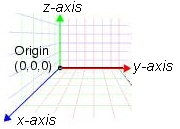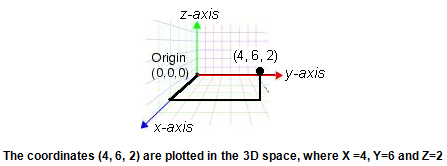Coordinates in 3D
The most basic visual entity in the 3D space is the point. The point has no size, but it does have a location. To determine the location of a point, first establish an arbitrary point in space as the origin.
X, Y, and Z Axes
We can say a point's location is:
-
A number of units along the X axis
-
A number of units along the Y axis
-
A number of units along the Z axis
The three dimensions are the
The point on each axis is represented by a number, and the point in space is expressed as the three axis numbers in XYZ sequence. This gives the 3D coordinates of a point in space. The point of origin is always expressed as(0, 0, 0). Where the three axis coordinates intersect, we have the coordinates in the 3D space.
World Space, Object Space, and Local Space
3D positions and transformations exist within coordinate systems called spaces.
-
is the coordinate system for the entire scene. Its origin is at the center of the scene. The image below shows the world space axes.
-
is the coordinate system from an object's point of view. The origin of object space is at the object's pivot point, and its axes are rotated with the object.
-
Local space is similar to object space; however it uses the origin and axes of the object's parent node in the hierarchy of objects. This is useful when you haven't transformed the object itself, but it is part of a group that is transformed.
See also:



